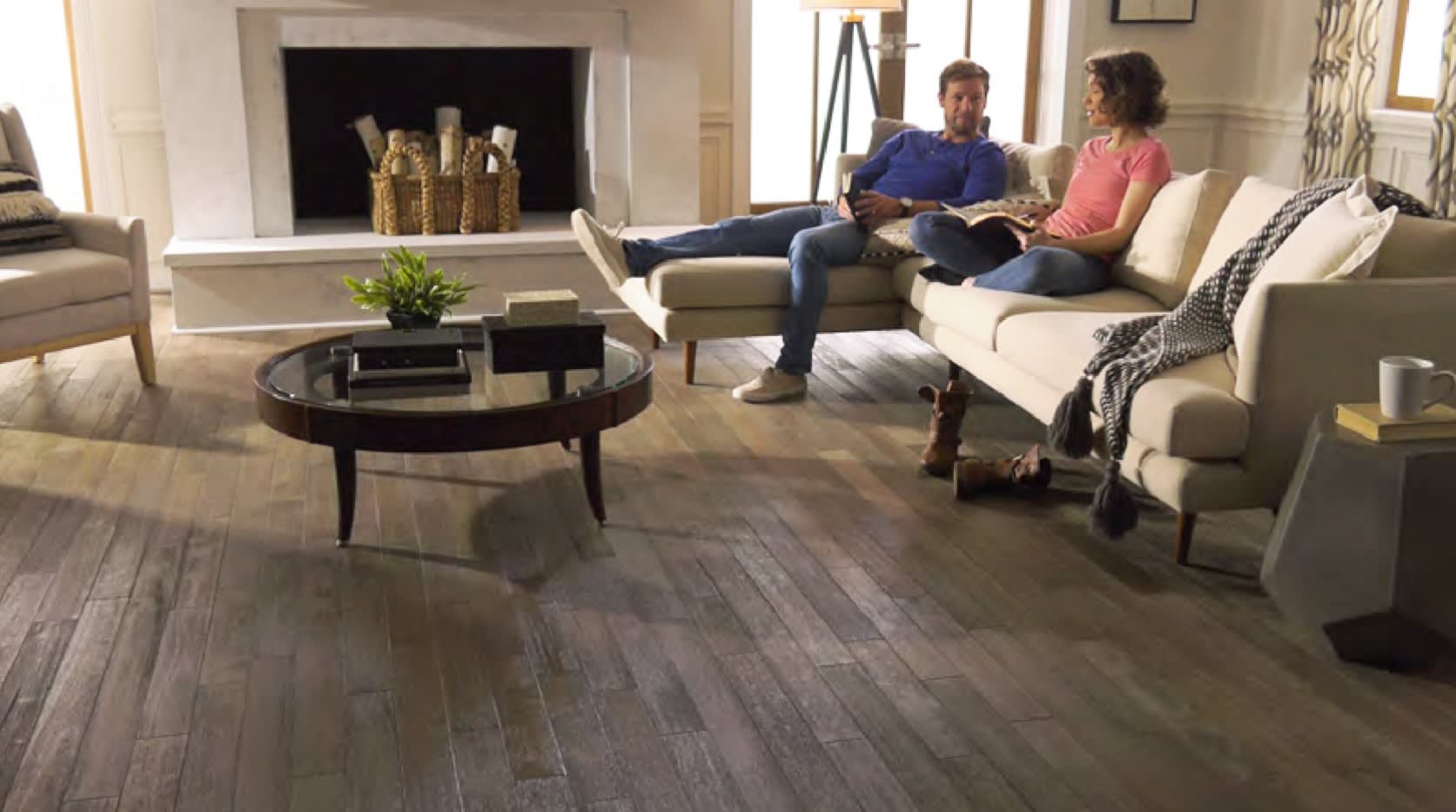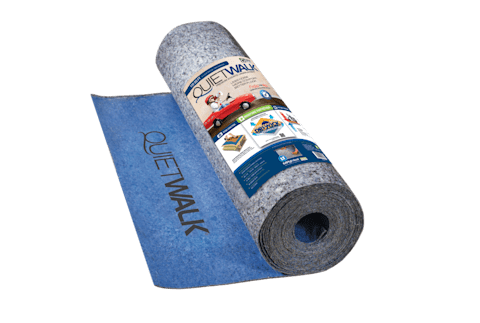- Home
- Education
- Planning Your Project
- Prepping for Your Floor Installation
Prepping for Your Floor Installation
You’ve researched options, compared samples, and finally picked out the flooring of your dreams. Now with installation day on the horizon, you’ll want to be confident you’ve made all the necessary preparations to ensure the project runs smoothly.
Whether you’ve arranged to have one of our Professional Independent Contractors complete the installation or plan to tackle it yourself, there are a number of steps to take and factors to consider as you prepare for the big day. These include having all the necessary materials on hand, making sure conditions are suitable for your new flooring, and creating a safe and accessible environment for the installation crew.

3/4 in. Misty Point Distressed Solid Hardwood Flooring 3.5 in. Wide
How Do I Get My Flooring Materials?
Flooring materials can be quite heavy and bulky, and even more so for larger projects such as commercial spaces and flooring for multiple rooms in a home. Also, some materials are heavier than others—for instance, porcelain tile as compared to cork. After you’ve chosen your floor, you may wonder what’s the best way to get those materials to your home. At LL Flooring, we offer a variety of delivery options to choose from: curbside store pickup, garage or curbside delivery, and indoor delivery.
If you’d like to pick up the materials yourself, select “store-pick-up” and choose the LL Flooring store closest to you. This is a free option, but there are a few questions you should ask yourself before going this route:
-First, is your vehicle big enough to carry the materials and also capable of supporting the weight?
-Then, once you’re home, how will you unload your materials to either bring them inside or store them securely outdoors?
Once you’ve addressed those issues and want to proceed with picking up your flooring materials, remember to bring your ID and credit card with you so that the process goes smoothly. If you choose garage or curbside delivery, you’ll need to have a flat, paved driveway accessible by a large box truck or tractor trailer.
Garage delivery is suitable for flooring materials and accessories that don’t need to be acclimated to your home environment, such as tiles. In the case of curbside delivery, you’ll be responsible for bringing your flooring inside or securing it if you plan to leave it outside. Both garage and curbside delivery are available for a flat fee.
“White Glove” indoor delivery service is our full-service option, allowing you to have your flooring materials and accessories delivered into your home. All that’s necessary is a safe and accessible walkway that’s free of obstacles, and cleared areas in the home to store the materials. Keep in mind that flooring products such as hardwood require a period of acclimation before they’re installed. They'll need to be left in the room where the installation will take place or in an area that has similar conditions, so they can adjust to the ambient temperature and humidity levels. In the case of hardwood, this could take a few weeks.
Whatever flooring options you’ve chosen, it’s important to verify that all the flooring installation materials for your project are in place and ready to go by the scheduled installation date.
What Issues May I Need to Address Before Installing Flooring?
When you order installation, one of our Professional Independent Contractors will come by to assess the project. The process may reveal subfloor issues or other structural concerns that need addressing before the installation can begin. In that case, you may have to hire another contractor to fix the issue before installation can proceed. Sometimes these subfloor issues aren’t discovered until your old flooring is removed during the actual installation project.
If the Professional Independent Contractor is able to remedy the problem, you’ll get an estimate to approve for the work and an adjustment to your installation schedule. If the work requires the expertise of a different tradesperson, the installation will continue once the work is completed and reviewed by the installer.
Not all subfloor imperfections require major work, though. Some can be resolved with just a few minor repairs. For instance, your subfloor may require nothing more than a bit of smoothing out and patching up, and you can easily find products to even out the surface. Or you may have to adjust your underlayment so that it's compatible with the flooring material you’ve chosen. If you’d like to install tile but your subfloor is constructed from plywood, you can purchase cement backerboard to place between the plywood and your tiles for stabilization. This will prevent your tiles from cracking. Also, protective barriers such as 6 mil poly sheeting protect laminate and other flooring types from the moisture associated with concrete. At LL Flooring, we carry a variety of subfloor prep items as well as underlayment among our selection of installation materials.
How Do I Prepare My Space for My Flooring Installation?
Be prepared to perform any labor that you haven’t contracted with LL Flooring. We do offer furniture moving, although there are certain items that you'll have to take care of on your end. These include pool tables, sports equipment, pianos, fish tanks, entertainment centers, and specialty beds. Also, our installation providers will not break down, pack up, or reassemble furniture other than standard bed frames. Regardless of who will be moving your larger furniture pieces, you’ll be the one packing up all the loose items.
It’s best to contact the Project Coordination office beforehand if there’s anything you’re not sure about. Also keep in mind that you may nave to hire a separate contractor to disconnect and reconnect gas appliances, gas lines, water lines, sinks, and toilets if necessary for your flooring installation. Below is a general room-by-room guide to get you thinking about how to efficiently prepare your space. Along the way, you may even decide that this is the perfect time to give your décor a little refresh to go with your new flooring.
Living Room and Dining Room
Move out your lamps, vases, and any other objects on your tabletops and floors. You may be able to simply move them to another room. But be mindful of cluttering up adjoining rooms that may be needed for tools and other items during the installation process. In that case, it’s best to move these items to another floor of your home, into a closet, or outside. You’ll want to remove books from bookshelves and objects from inside china cabinets—anything that could possibly spill out or break. Simply pack them up in boxes as if you’re moving, wrapping delicate items to ensure they stay in one piece. It’s also a good idea to remove items from built-in shelving to prevent accidental damage. The same goes for wall décor.
Lastly, consolidate your furniture items by stacking smaller tables upside down on larger ones and stowing chairs upside down along the edges of your tables.
Bathroom and Kitchen
Bathrooms are relatively easy, since they usually don’t contain a lot of standalone items. You still want to clear shelves and countertops to make sure nothing gets knocked down or interferes with the work being done. Also remove scales, floor mats, and any other items on the floor. When preparing your kitchen, you don’t have to worry about what’s inside your built-in cabinets, but you'll want to clear knickknacks from your countertops and remove items from stands and open shelving. And don’t forget about the pet bowls. Bedroom For many, the space under the bed doubles as a storage area. Be sure to relocate those items—and if your flooring will extend into the closet, make sure that floor is clear as well. The rest of the clearing you’ll do is similar to any other room in your house, including moving out important and delicate items that may get inadvertently damaged during the installation process.
Basement
Basements are often filled with odds and ends. This would be a good time to sort through your collection and decide which items you want to keep. If you have a walk-out basement, you can temporarily move things into your garage or outside.
Home Office
Move your delicate office equipment to a safe area and clear paperwork, books, and folders from your shelves. It’s a good idea to stay organized and make use of labels so that you don't loose track of important items and can quickly put your office back together again after the flooring installation.
Creating an Accessible and Safe Work Environment
Your site should be easily accessible and safe for the professionals installing your flooring. In addition to taking the above steps to ready your rooms, make sure that you maintain clear paths to your home and to the room or rooms involved. Keep children, pets, and other household members safely out of the way. Flooring installation can be loud, and there may be some dust and odors from adhesives and sealants. Also, the installers can’t be responsible for keeping pets from escaping as they enter and exit your home during the process.
Plan to Be Present
Although it’s best for pets and sensitive household members to be somewhere else during the flooring installation, it’s important for you or a responsible representative to be present onsite. There are a few reasons for this. For instance, one of the appeals of natural hardwood is its variation—every board is unique—so if you come across a board that’s unacceptable to you, inform the Professional Independent Contractor as soon as possible. You may decide that you prefer to use it in a different location or not at all. It's also much easier to address issues that require input if someone is there.
When it comes to prepping for your flooring installation, the earlier the better. You can start by creating a "To Do" list based on this guide and from information on the professional installation page of our website. Be sure to carefully review your contract for details specific to your project and also look out for related e-mails from us in the days leading up to installation. We want to make your new floor journey as stress-free as possible. Feel free to contact our Project Coordination office with any questions you may have at 1-800-651-1635.
Also, do you like ideas and how-to videos about design and decor on YouTube?
Please SUBSCRIBE to the LL Flooring YouTube Channel to learn more, leave comments or ideas that helped you, and join the community!





